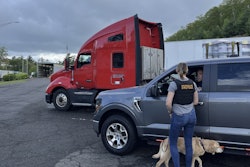Lube Job
Frequent, thorough greasing is vital to ensuring the reliability and long life of many expensive components
Any successful owner-operator will tell you he’s saved money over the years by greasing his rig as frequently as possible. Greasing is an easy job that even an inexperienced mechanic can easily perform. It’s normally best to grease at least once between oil changes with the longer change intervals allowed today.
1. Grab your owner’s manual and find out what kind of grease is recommended for your vehicle. Most manufacturers recommend NLGI (National Lubes and Grease Institute) No. 2. The numbers refer to the thickness of the grease, 00 for semi-solid grease used in some wheel bearings, and 7 for grease that’s like a cake of soap. Make sure slack adjusters get the proper grease, which may be different.
2. Check the manual for a list of components that need grease. These typically include: steering components like universal joints, slip yokes, control arms, tie rods, and kingpins; driveshaft crosses and center bearings; automatic slack adjusters and the camshaft bushings nearby; spring shackle pins and, sometimes, spring hangers; and fifth wheel grease points and the fifth wheel plate that supports the trailer. On trailers, the spring and suspension components need greasing, as well as the landing gear.

3. Starting at the front of your vehicle, grease every component that has a zerk fitting. Looking for zerks is one way to avoid missing anything. You can see a zerk in this illustration of a landing gear’s gearbox. The zerk is near the top, and is a small, screw-in fitting with a point on the end with a small hole where the grease can pass into the component.
4. Purge dirty grease from the end of the grease gun by pumping the handle once or twice. Wipe each zerk fitting with a clean rag first. Do this to keep road grime from being forced into the component, which increases wear.
5. Install the female fitting on the end of the grease gun onto the zerk by lining it up straight and then forcing it on. You’ll feel it snap into place. Slowly and gently pump the handle on the grease gun. You may need to pull it all the way out to start the process. Slowly pump grease into the fitting with the gun until fresh grease (the color of what’s in the cartridge) oozes out. In this case the technician is greasing a driveshaft cross. These must be greased until fresh grease emerges from all four bearings.
6. Wipe off excess grease, then pull the grease gun off the zerk. Repeat for items such as:
7. Steering tie rods.
8. Slack adjusters. Slacks should be greased until fresh grease emerges in the center, where there are splines, so you can see only fresh grease.
9. Fifth wheel bearings.
10. Driveshaft center bearings.
11. The fifth wheel plate. First wipe old grease off the plate, then spread grease all over so when you hook to a trailer it will form a consistent film.
12. When greasing kingpins, refer to the owner’s manual for the correct procedure. Some need to be greased with the truck on the floor, others with the truck jacked up to lift the wheels off the floor, and still others both ways or with one end greased in each condition.
13. When oil-filled wheel bearings are used, the fill plug should be removed and the bearing filled until it drips with the recommended lubricating oil, or, when fitted with a sight glass, oil shows on a fill line. Bearings using semi-solid grease are filled like those using plain oil. Bearings that are greased require periodic disassembly and repacking with fresh grease, a job suitable only for skilled technicians.
14. If you own your trailer, grease the landing gear. Follow special procedures-the legs are normally greased when moved to a position a couple turns from the top.
Big Rig Basics Tip
Owner-operator Earl Evans, of Canfield, Ohio, carries a grease gun. He says, “By greasing every 2,500 miles, I’ve never replaced any greased component on any of my rigs.”
He adds, “Grease a fitting until you can see fresh grease all around. If the old grease is still fresh and you can’t tell when the new grease comes out, just make sure to push out as much as you’ve pumped in.”
LUBRICATION
Level of difficulty: (scale of 1-10 with10 being the hardest job): 3
Time needed: About one hour.
Tools needed:
1. High quality, cartridge-type grease gun that handles grease cartridges. You can also use a bulk loader with pump. This makes loading easier.
2. Grease cartridges containing the proper type or types of grease (see below).
3. If components such as kingpins need to be greased with the truck off the wheels, a floor jack and axle stands of adequate capacity to support your rig.
4. Several clean rags.
PRODUCT TIP
All the major oil refiners have produced special greases adapted to longer oil change intervals. If you can’t grease at least twice between each oil change, then switch from standard grease to a grease specifically designed for longer intervals. Chevron introduced Delo Grease ESI (extended service intervals). If you have another favorite brand, ask for a mineral or synthetic grease that will avoid washout and prevent wear for longer than traditional products.








